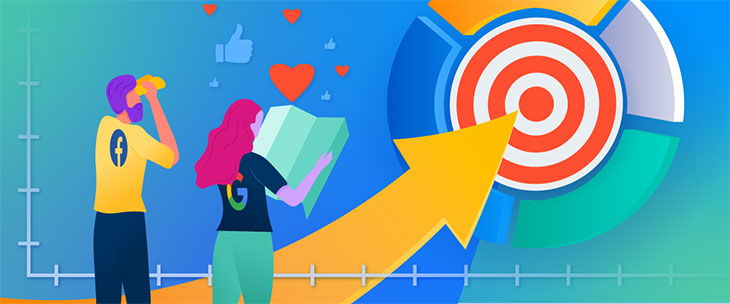Running a company means making tough business decisions. That holds true for your marketing efforts as well. We’re often asked whether an organization should use Facebook or Google ads. The answer is always both, but with different goals and strategies for each platform.
In this blog, we’ll reveal three ways to use social media to support your PPC campaigns, and vice versa.
Before we dive in, it’s important to understand the fundamentals that make these platforms unique. In short, Google is demand-driven, meaning people use search engines to explore new products and shop for goods or services. On the other hand, Facebook largely relies on building that demand by introducing your brand to new potential customers. Think of this as push and pull marketing.
1. Take an Omni-Channel Approach
Google and Facebook work and play well together. Facebook generates demand, which Google can capitalize on. For example, Facebook ads lead to branded searches on Google and other search engines.
Individually, paid search and paid social ads provide tons of data, but Facebook’s (FB) parent company Meta’s suite of products (Facebook, Instagram, Messenger) is a superior cold audience generator. Meta has access to key information, such as age, demographic, location, and first-party data based on ads web users have interacted with. It also compiles data on visited websites and can match customer lists to individual Facebook profiles. This helps build a healthy top of funnel for your PPC ads to close.
2. Build a Target Audience
Working with both, we can target four main content categories in search of audiences: location, age, gender, and language. Facebook is also great at prospecting and remarketing. Algorithmically, detailed targeting can further break down a raw audience based on broad demographics into hobbies, likes, behavior, interests, interactions, activity, and more. For example, targeting a large group of individuals aged 25 to 65 who are unmarried can total in the millions. With Facebook we can filter that group down into a more manageable list of those most likely to convert for a specific product.
3. Plan and Budget
When planning your social ads we recommend anywhere from four to eight prospecting and remarketing ads to run at the top of the funnel. Technically you can run up to 50 ads at once, but four to eight is our suggested sweet spot. As social ads run, data is derived to show their effectiveness, which we use to inform our account optimizations on paid search. For example, when we scale our efforts on paid social, we can expect to see increased search volume in our PPC campaigns. It’s best to start broad and use paid search and paid social media marketing services to identify top-performing ads and ensure they’re getting the budget they need.
While paid search and paid social advertising have a supporting impact on one another, it’s important to note that different goals should be set for either platform. Remember that each tool has its benefits, and it’s best to first understand the capabilities of both and how they work together. Furthermore, continue testing to provide an ongoing analysis of what’s working and what is not, so you can forecast accordingly.
If you want to learn more about paid search and paid social media marketing services, and how a custom omni-channel approach to digital marketing can work for you and your company, contact Logical Position.



